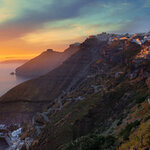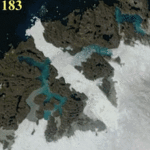Geology

Nuclear waste is one of the biggest downsides to nuclear power, and can remain dangerous for hundreds of thousands of years. Geological disposal is often stated as the most preferable way of dealing with it, but what does it entail? What are the problems that need to be overcome, and how are governments going about overcoming them? Fortunately, most governments are trying to be transparent about the process, with thousands of reports available on the web. For some coursework earlier this year, I looked at the subject from a geological point of view.
Green protesters…

Several Italian scientists may be charged later this year with manslaughter over the deaths of 308 people who died in and around l'Aquila in 2009. Is this reasonable?
I wanted to write about something new in this post, but as Google News failed to inform me of any interesting geology-related happenings (unless you include this BBC article which is just one big rock pun) I will have to make do with something almost-current I have wanted to write about for a while.
Back at the beginning of June, seven Italian scientists and officials were accused by the l'Aquila public prosecutor of…

As a first post (ever) I would like to write a little about Santorini, the volcano I plan to spend the next three years studying. It may be a little self-indulgent, but I hope you'll find this volcano is interesting enough regardless.
Cliffs of Santorini's caldera, CC-BY by Flickr user hozinja.
Perhaps the most well know eruption of Santorini was the one that is thought to have ended the Minoan civilisation on Crete. Dated to around 1610 BC, this eruption was large. It released at least 30 km3 of ash and unleashed tsunamis, both of which reached Crete and would have…
A team of scientists say they have reconstructed the Earth's climate belts of the late Ordovician Period, between 460 and 445 million years ago, and their study says these ancient climate belts were surprisingly like those of the present.
The team of scientists looked at the global distribution of fossils called chitinozoans – probably the egg-cases of extinct planktonic animals – before and during this Ordovician glaciation, and found a pattern that revealed the position of ancient climate belts, including such features as the polar front, which separates cold polar waters from more…

Ashfall On Katla
Unless you have been vacationing on the far side of the moon, you will have seen lots of pictures of the recent Eyjafjallajökull eruption.
Location map, courtesy Wikimedia Commons
On July 12 there was a break in the clouds over Iceland making it possible to see the area of the volcano. I have been waiting for a better picture, but according to Murphy's law the cloud will only disperse fully once I have lost patience with waiting and posted the Jul 12 image.
On July 12 2009 Eyjafjallajökull's neighbor Katla's Mýrdalsjökull ice cap was clean and white.
Eyjafjallajökull…

Jakobshavn Glacier Second Calving ?The calving front of Jakobshavn glacier has retreated dramatically since about 1850, to the point that the two main outflow ice streams can be seen as separate calving fronts, Jakobshavn North and South.
Jakobshavn North recently calved a large floe which was widely reported by Arctic watchers and then picked up by the news media - and hyped up.
For a non-hyped report I recommend http://neven1.typepad.com/blog/.../jakobshavn...
Jakobshavn South appears to have recently calved a similar amount also, some time between the 10th and 16th of July 2010.
The…

What I don't understand is why the Former States of the Soviet Union need Russia in their affairs. They would be much better off working together, considering that they share a language. The violence is out of control and Russia with few human policies doesn't respect fringe cultures. They need to compete with china who has a functional economy these days.

Is Eyjafjallajökull Playing Possum?
Since the April and early May grounding of aircraft in much of Europe, the Eyjafjallajökull eruption has been producing - relatively - much less plume and appears to be dying down. It is natural to ask: is Eyjafjallajökull playing possum, or does the volcano still pose a risk to European airspace?
Southern Iceland. Part of MODIS/ Terra image:http://rapidfire.sci.gsfc.nasa.gov/subsets/?subset=Arctic_r01c03.2010153...
A previous eruption of Eyjafjallajökull lasted about a year. In the sphere of law, one prededent makes a rule, but not in science.…

The Yangtze River in China is 40 million years older than was previously thought, according to new research.
A study of minerals reveals that the Yangtze River began to cut the Three Gorges area around 45 million years ago, making it much older than previously believed.
The Yangtze River, the third-longest river in the world, has played a central role in the development of Chinese culture, and the Three Gorges, which separate the Sichuan Basin in the west from the lowlands of central and eastern China to the east, have particular historical, cultural, and geomorphological significance.…

A major earthquake, comparable to the one that hit Chile earlier this year, could strike the Pacific Northwest coast of the United States, Oregon State geologists say.There is more than a one-in-three chance that it will happen within the next 50 years.
The team's new analysis has provided fresh insights into the Northwest's turbulent seismic history – where magnitude 8.2 (or higher) earthquakes have occurred 41 times during the past 10,000 years. Those earthquakes were thought to generally occur every 500 years, but as scientists delve more deeply into the offshore sediments and other…